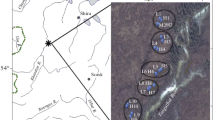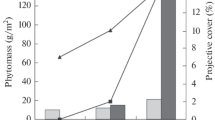Abstract
An assessment of the degree of contrast in the physicochemical properties of pyrogenic peat soils and fire-induced carbon losses 20 years after a major fire that partially destroyed a swamp spruce forest (Picea obovata Ledeb.) located within a complex of small river valleys in Kuznetsk Alatau, Republic of Khakassia, is made. The area affected by the fire is currently occupied by a shrub–sedge–green moss–hypnum birch forest (Betula pubescens Ehrh.) belonging to the group of short-term–secondary postfire grass forests. The pyrogenic peat soils (i.e., mechanical and chemical underburning) that formed as a result of passive smoldering (i.e., thermal impact below the ignition point) feature a high variability of physicochemical parameters (Cv = 26–37%). The application of multivariate statistical analysis techniques (cluster, discriminant, and canonical analysis) has made it possible to distinguish and statistically substantiate four clusters that correlate with the series of pyrogenic peat soils. Organic carbon makes the greatest (83%) input into the total contribution of chemical parameters to the differentiation of clusters, while the input of the volumetric water content is significantly less (15%). Based on the diversity and abundance of fire traces in the profile of pyrogenic peat soils, the distinguished clusters have been conditionally associated with slight, moderate, medium, and strong thermal impacts. Proportionally to the fire impact intensity, the soil clusters are enriched with ash components by 1.6–2.7 times (the ash content varies from 18.9 to 77%) and compacted by 2.2–4.3 times (the bulk weight reaches 0.147–0.421 g/cm3), while their pH value gradually changes from 6.8 to 7.6. A new approach to assessing carbon losses that occur in the course of passive peat smoldering is proposed. The new approach is based on the difference in the carbon content before and after the fire; it supplements the traditional method based on the peat-deposit incineration depth. The additional carbon losses in the 0- to 20-cm layer of pyrogenic peat soils vary in the range from 1.6 to 4.0 kg/m2, which is equivalent to 5.9–14.8 kg/m2 in CO2 emissions. The data on additional carbon losses at the stage of passive peat deposit smoldering are presented for the first time.



Similar content being viewed by others
REFERENCES
Agrokhimicheskie metody issledovaniya pochv (Agrochemical Methods of Soil Research), Moscow: Nauka, 1975.
Amosov, G.P., Nekotorye osobennosti goreniya pri lesnykh pozharakh (Some Features of Burning in Forest Fires), Leningrad: LenNIILCH, 1958.
Dyrness, C.T. and Norum, R.A., The effects of experimental fires on black spruce forest floors in interior Alaska, Can. J. For. Res., 1983, vol. 13, pp. 879–893.
Efremova, T.T., Avrova, A.F., and Efremov, S.P., Morphogenetic litter types of bog spruce forests, Sib. Lesn. Zh., 2015, no. 1, pp. 58–73.
Efremova, T.T., Avrova, A.F., and Efremov, S.P., A calculation method for determination of carbon in the peat and moss litter of forest swamps by ash content of plant substrates, Sib. Lesn. Zh., 2016, no. 6, pp. 73–83.
Efremova, T.T., Avrova, A.F., and Efremov, S.P., Spatial differentiation of carbon storages in peat soils of paludified spruce forests on eastern slopes of Kuznetsk Alatau, Lesovedenie, 2018, no. 4, pp. 273–284. https://doi.org/10.15372/SJFS20160607
Furyaev, V.V., Influence of ground water levels on fire maturation of swampy and boggy forests in the interfluvial area of Ket-Chulym, in Voprosy lesnoi pirologii (Problems of Forest Pyrology), Krasnoyarsk, 1970, pp. 186–220.
Gundar, S.V., Soil fires in the Lower Amur basin, their prevention, and suppression, Extended Abstract of Cand. Sci. (Agric.) Dissertation, Krasnoyarsk, 1978.
Huang, X. and Rein, G., Downward spread of smouldering peat fire: The role of moisture, density and oxygen supply, Int. J. Wildland Fire, 2017, vol. 26, pp. 907–918. https://doi.org/10.1071/WF16198
Jae-On Kim, Mueller, Ch.W., Klecka, W.R., Aldenderfer, M.S., and Blashfield, R.K., Faktornyi, diskriminantnyi i klasternyi analiz (Factor, Discriminant, and Cluster Analysis)), Moscow: Finans. Stat., 1989.
Kachinskii, N.A., Fizika pochvy (Soil Physics), Moscow: Vyssh. Shk., 1965.
Kasischke, E.S. and Johnstone, J.F., Variation in post-fire organic layer thickness in a black spruce forest complex in interior Alaska and its effects on soil temperature and moisture, Can. J. For. Res., 2005, vol. 35, pp. 2164–2177.
Khalafyan, A.A., STATISTICA 6. Statisticheskii analiz dannykh (STATISTICA 6. Statistical Analysis of Data), Moscow: OOO Binom-Press, 2007.
Krasnoshchekov, Y.N., Postpyrogenic variability of litter in mountain forests of Baikal region, Eurasian Soil Science, 2019, vol. 52, no. 3, pp. 258–270. https://doi.org/10.1134/S1064229319030086
Kurbatskii, N.P., Krasavina, N.N., and Zhdanko, V.A., Lesnye pochvennye pozhary i bor’ba s nimi (Forest Soil Fires and Their Control), Leningrad, 1957.
Laikom, A.O. and Golubina, O.A., Degradation of pyrogen peat soil under fires (data of Tagan field), Vestn. Tomsk. Gos. Pedagog. Univ., 2013, no. 8, pp. 137–142.
Lipatov, D.N., Shcheglov, A.I., Manakhov, D.V., and Brekhov, P.T., Spatial heterogeneity in the properties of high-moor peat soils under local pyrogenesis in northeastern Sakhalin, Eurasian Soil Science, 2016, vol. 49, no. 2, pp. 238–250. .https://doi.org/10.1134/S1064229316020071
Melekhov, I.S., Dusha-Gudym, S.I., and Sergeeva, E.P., Lesnaya pirologiya: Uchebnoe posobie (Forest Pyrology: Handbook), Moscow: Mosk. Gos. Univ. Lesa, 2007.
Miyanishi, K. and Johnson, E.A., Process and patterns of duff consumption in the mixwood boreal forest, Can. J. For. Res., 2002, vol. 32, pp. 1285–1295.
Nazimova, D.I., Ponomarev, E.I., and Konovalova, M.E., The role of an altitudinal zonal basis and remote sensing data in sustainable management of the mountain forests, Lesovedenie, 2020, no. 1, pp. 3–17. https://doi.org/10.31857/S0024114820010106
Ponomarev, E.I. and Kharuk, V.I., Wildfire occurrence in forests of the Altai-Sayan region under current climate changes, Contemp. Probl. Ecol., 2016, vol. 9, no. 1, pp. 29–36. https://doi.org/10.1134/S199542551601011X
Rakovskii, V.E., Kaganovich, F.L., and Novichkova, E.A., Khimiya pirogennykh protsessov (Chemistry of Pyrogenic Processes), Minsk: Akad. Nauk BSSR, 1959.
Sirin, A.A., Makarov, D.A., Gummert, I., Maslov, A.A., and Gul’be, Ya.I., Depth of peat burning and carbon losses from an underground forest fire, Lesovedenie, 2019, no. 5, pp. 410–422. https://doi.org/10.1134/S0024114819050097
Sofronov, M.A. and Volokitina, A.V., Fire in swamp forests of western Siberia, in Gidromorfnye lesobolotnye ekosistemy (Hydromorphic Forest Ecosystems), Krasnoyarsk: IliD, 1986, pp. 139–150.
Sofronov, M.A. and Volokitina, A.V., Metodika obsledovaniya i opisaniya lesnykh uchastkov, proydennykh pozharami (Methods of Survey and Description of Forest Areas Affected by Fires), Krasnoyarsk: Inst. Lesa im. V. N. Sukacheva Sib. Otd. Ross. Akad. Nauk, 2007.
Sofronov, M.A. and Volokitina, A.V., Rekomendatsii po okhrane ot pozharov yuzhno-tayezhnykh zabolochennykh lesov Sibiri (Recommendations for Fire Protection of Southern Taiga Wetlands in Siberia), Krasnoyarsk: Inst. Lesa im. V. N. Sukacheva Sib. Otd. Ross. Akad. Nauk, 2012.
Trofimova, I.E., Osipova, O.P., and Balybina, A.S., Approaches to evaluating climate and ecological resources of Siberia, Contemp. Probl. Ecol., 2019, vol. 12, no. 5, pp. 444–452. https://doi.org/10.1134/S1995425519050111
Wieder, R.K., Scott, K.D., Kamminga, K.K., Vile, M.A., Vitt, D.H., Bone, T., Xu, B., Benscoter, B.W., and Bhatti, J.S., Postfire carbon balance in boreal bogs of Alberta, Canada, Global Change Biol., 2009, vol. 15, pp. 63–81.
Author information
Authors and Affiliations
Corresponding author
Ethics declarations
The authors declare that they have no conflicts of interest. This article does not contain any studies involving animals or human participants performed by any of the authors.
Additional information
Translated by L. Emeliyanov
Rights and permissions
About this article
Cite this article
Efremova, T.T., Pimenov, A.V., Efremov, S.P. et al. Impacts of Forest–Peat Fires on Soils and Their Influence on Carbon Losses in Phytogenic Microelevations of Mountain Swamps in the Southern Part of Central Siberia. Contemp. Probl. Ecol. 14, 279–289 (2021). https://doi.org/10.1134/S1995425521030057
Received:
Revised:
Accepted:
Published:
Issue Date:
DOI: https://doi.org/10.1134/S1995425521030057




